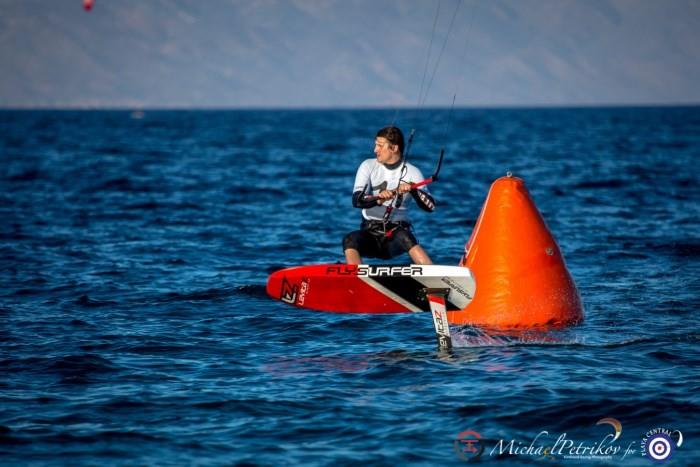Kitefoiling - Tube or foil kite?
Categories:
- Foil (ram-air) race-performance kite with AR7 (e.g. Flysurfer Sonic-FR, Ozone R1, Elf Joker, Fone Diablo)
- Foil (ram-air) all round-performance kite with AR6 (e.g. Flysurfer Speed4 Lotus)>
- LEI/ Tube SLE performance kite with AR6 (e.g. Flysurfer Boost, Ozone Edge, North Dyno)
(AR = site ratio or thinness of kite)
Race performance kite
Competitive kite racers enjoy many benefits that race kite offers in comparison to all-round foil kites or tube kites. Kiting close-hauled under full power the race kite allows hitting a better sharper angle toward the wind of about 1.8 degrees at the identical riding speed. At a distance of one kilometer, this produces a difference more than 30 meters – that may determine who the winner of the race will be. In the rough winds about 30 knots, kite control is the highest priority. Even top racers in those mentioned conditions prefer the shape of stability of a tube kite. This shape offers more relaxed kite handling.
Free riding in low winds
The main advantage of hydrofoiling is capability of kiting in very low winds. Keeping the kite on a sky is the only challenge. Due to this fact is the main factor weight of the kite.
No.1 in this category is still Flysurfer's Speed4 Lotus. Thanks to its design with small amount of cells with innovative Lotus material, that offers a high density and either water or dirt repellent fabric, assure the lightest weight possible. Currently the Speed4 Lotus kite is the lightest available kite on the market with starting from water. Whether a slight loss of your upwind angle does not hurt, Lotus Speed4 fits as the best kite for free ring on a hydrofoil. Nowadays it is a real fact (not just a marketing tip), that it is possible to kite in a low wind conditions 5-6 knot. And it is a great fun!
In relation to this it is only fair to mention that mainly the equipment determines the kiter's ability to hydrofoil at low wind speeds. The experience and ability of the rider keeping the kite in the air through movement and to “pump up” the hydrofoil determine how early one can ride – even a Flysurfer Boost 15m LEI / tube kite may be ridden in 5 knot of winds on a hydrofoil board.
Kite controlling and depower
Whether you have experienced riding a hydrofoil with an overpowered kite you may realized what kind of speeds can be reached. You may also be aware of how painful a fall at that kind of speed may be. Otherwise with a twin tip, the edge of the hydrofoil cannot be used to slow down the kite and board by edging in the water. Here the option to depower becomes a very important possibility; especially in choppy and turbulent wind and water conditions. For the control and direct depower are favored LEI/tube kites (e.g. the Boost).
Kite relaunch
Thanks to Flysurfer´s overall technical properties, riding the foil in light wind is more fun than a problem. Just relaunching may be the limiting factor. To get the most out of your kite session having a kite that relaunches easily in light wind is a must have.
The Speed4 Lotus remains the most reliable foilkite relaunching at 5-6 knot of winds due to its light weight. Experienced kiters may also relaunch the kite Flysurfer SONIC-FR that leaves a little less room for error while giving the rider a higher performance. All in all, LEI/tube kites cannot be relaunched in wind conditions of 5-6 knots. The only exception in this case is the LightWind Edition of the Boost. The adaptive airfoil technology featured in the kite sizes 15.0m and 18.0m extremely simplifies the relaunch. This great property makes the Boost the only tube kite on the market that may be water-started this early – even with the board on your feet and after a sudden wind pull or wind drop, when you are lying in the water for a while.
The relaunch ability of the kite Boost-LW is a great pleasant feature especially for hydrofoil newbie's or for intense maneuver training sessions. Even in normal wind conditions flying the Boost offers many advantages. The less time you spent relaunching your kite, the more time you have to improve your skills.
Foil kite maneuver
The main goal of kitefoiling is to tack against the wind without touching the surface of the water. The low drag resistance of the Sonic-FR kite allows generating high up wind speed to start this or any maneuver. Kites Speed4 Lotus or the Boost are comparably suited for any foil action/ maneuver. Foiling jibes carry the risk for the kiter to under-ride or under-fly the kite when performed downwind. Kites like the Speed4 Lotus and the Boost therefore make it easier to progress your foiling skills. Moreover, the fast turning of the Boost allows for a quick downloop for a smooth passing through the power zone to safely complete this maneuver.
Kite versatility
Regarding to the fact that many kiters prefer using the same kite for different riding styles or disciplines the question arises whether a foil kite may likewise be ridden with a twin-tip at normal wind conditions. Universally, this is possible with any kite. The only thing to keep in mind is the treatment - according to the high used technology of a race kite (thinner lines and lighter internal structure). In general, dropping the kite on the surface of the water for about 30 times during a freestyle session might not be the best idea. Therefore the Boost (perfect for jumping/ kite loops) and the Speed4 (perfect for hangtime/ old school/ air style) are the recommended kites.
And what about you and kitefoiling?
Your advices and comparisions?




